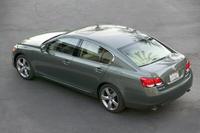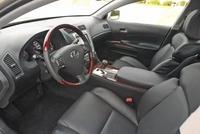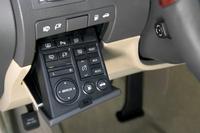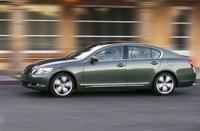2006 Lexus GS 430 Review
DRIVING DOWN THE ROAD
WITH CAREY RUSS
SEE ALSO: New Car Buyer's Guide for Lexus
When it debuted in the second-generation Lexus GS lineup in model year 1998, the V8-powered GS400 added serious performance to Lexus's expected refinement and luxury. Its styling was an evolution of that introduced on the original inline six-cylinder GS 300 back in 1993, but bolder and with more attitude. Few parts underneath that skin interchanged with the earlier GS. And performance was steadily increased. The factory even started a successful racing effort in 1999. For the 2001 model year, a new and larger engine bumped the performance factor further as the GS 400 became the GS 430.
We're barely into 2005, but the 2006 GS is now here. And, while the styling is a further refinement of the now-familiar GS coupe-like theme, there are again some very significant changes under the skin. The third-generation GS is a technological tour de force that points to future directions for all Lexus cars, not only in looks but in materials and sophisticated electronic control systems as well.
Lexus has a motto that goes as follows: ``Anticipate a customer's needs and desires and meet or exceed them.'' This refers not only to the expected (and unexpected) comfort and convenience elements, which are designed to do just that, but additionally in the GS 430, elements of ride, handling, and vehicle control. ``Adaptive Vehicle Suspension'' (AVS) automatically selects the appropriate suspension damping level. The ``Vehicle Dynamics Integrated Management'' system (VDIM) integrates sensors and controls from the ``Electronically Controlled Brake'' (ECB), ``Variable Gear Ratio Steering'' (VGRS), Electronic Power Steering'' (EPS), ``Vehicle Stability Control'' (VSC), antilock braking, brake assist, electronic brake force distribution (EBD), electronic throttle, and engine management systems to monitor conditions, anticipate the onset of a skid or slide, and enhance control with a combination of braking, throttle, and steering control. For instance, VSC could gently use one specific brake to help get the car in line, while VGRS dials up quicker steering response and ECB provides faster overall braking response. If it sounds like an alphabet soup of acronyms appropriate to jet fighter technology, well, it is. And, as there are redundant control systems in aircraft, so the ECB system is backed up by conventional hydraulic controls.
Between the first time I saw and drove the new GS, at the regional press introduction a few weeks ago, and the past week, which I spent with a new GS 430 at home, I had the opportunity to drive one for a few laps around the Laguna Seca racetrack. It was completely happy in that environment, and felt as solid, stable, and maneuverable as any of its competitors. Back at home, I've had few cars that have gotten as many compliments from as wide a variety of people. Lexus is no longer the newcomer in the sports-luxury field, it is a serious competitor, and the new GS 430 is a fine example of a contemporary sports-luxury car.
APPEARANCE: Slick trick - although the new GS is actually slightly larger overall than its predecessor, by an inch or less in most dimensions, its smoother new styling makes it look smaller. The restyling is more evolutionary than revolutionary - visualize a generation two GS, then smooth out the front, and, with a more gentle slope, extend the rear of the greenhouse rearwards, almost to the lip of the trunk lid. The trademark four headlights remain in front, as does the waterfall grille, but both the lights and grille have been made smaller and sleeker. At the sides, a prominent shoulder line visually splits the upper and lower body parts, and moderately-blistered front fenders hint at performance. The rear is the most changed part, with the old front-mimicking quad separate taillights replaced by lights integrated two on a side under inclusive covers. My test GS 430 came equipped with ultra-low profile performance tires on metallic gray-finished alloy wheels that did an admirable job of camouflaging brake dust.
COMFORT: Put the ``Smart Access'' keyless entry fob in your pocket, and walk up to a new GS. The car will chirp as it automatically unlocks. Open the door and get in. With your foot on the brake pedal, press the ``start'' button. No, Lexus is not the first manufacturer to use such a system, but the Lexus implementation is one of the most functional. It'll be had to go back to an old-fashioned key. Once inside, welcome to the new look of Lexus. While the expected sumptuous comfort is there, with excellent standard heated perforated leather seats, wood trim, and all of the usual power accessories, the styling is fresh and more angular. Control and instrument layout enhances the driving experience, and requires no complex learning curve on the part of the driver. The main instruments have machined aluminum facings, and use a unique lighting system that makes them easily visible at all times. Less-used controls are hidden behind a panel to the left of the steering wheel. The interface for the optional navigation system is a major improvement over the last generation. Instead of having the audio, climate, and other systems controlled from sub (and sub-sub-sub...) menus on the touch screen, the major systems are controlled by well-marked buttons surrounding the screen. Touch menus are used as sparingly as possible. Intuitive, no learning curve, no confusion! The extra two inches added to the wheelbase seems to have gone into rear-seat legroom, which should make tall passengers happy.
SAFETY: And you thought we were done with the acronyms.... Besides having all of the expected passive safety devices including front, side, knee, and side curtain airbags, and active safety enhanced by VDIM, the new Lexus GS's ``Omni Directional Compatibility Body Structure'' (ODBCS) surrounds occupants with controlled-crushable front, rear, and side zones. The optional ``Pre-Collision System'' (PCS) uses a radar sensor to detect obstacles in front of the car and computerized systems to quicken the car's reflexes if a collision is deemed imminent.
RIDE AND HANDLING: Performance driving requires firm spring and shock settings to minimize weight transfer from acceleration, deceleration, and cornering. A luxury ride requires softer settings for comfort. In the GS 430, both requirements are met. The new suspension incorporates both anti-lift and anti-squat geometry to handle fore-and-aft weight transfer. The driver can select ``normal'' or ``sport'' modes for the AVS variable-damping shocks. ``Sport'' is a touch firmer, and still quite comfortable. As mentioned, the GS 430 acquitted itself very well on the track, at a speed level higher than I'd drive on the street. It was also as smooth, quiet, and comfortable as expected on the highway and around town. The VGRS allows good steering feedback and road feel, with effort appropriate to road speed, and never feels numb.
PERFORMANCE: The 2006 GS 430's namesake engine is mostly unchanged. No complaints there - 300 horsepower (at 5600 rpm) and 325 lb-ft of torque (at 3400 rpm) from a 4.3-liter V8 are not anemic, and average fuel economy in the neighborhood of 20 mpg is good for a high-performance sedan. The major driveline change this year is the transmission. The old five-speed automatic has given way to a new manually-shiftable six-speed. More ratios and smaller steps between them mean improved performance and economy. VVT-i variable valve timing helps give a broad torque curve, so that shifting is rarely necessary.
CONCLUSIONS: Warning to all competitors: With the new 2006 GS 430, Lexus has its sights on becoming the benchmark in the sports-luxury class as it is in the regular luxury class.
SPECIFICATIONSSIDEBAR: GS300 and Future Developments
2006 Lexus GS 430Base Price $ 51,125 Price As Tested $ 58,334 Engine Type 32-valve dual overhead cam aluminum alloy V8 with VVT-i variable valve timing Engine Size 4.3 liters / 262 cu. in. Horsepower 300 @ 5600 rpm Torque (lb-ft) 325 @ 3400 rpm Transmission 6-speed automatic Wheelbase / Length 112.2 in. / 190.0 in. Curb Weight 3,745 lbs. Pounds Per Horsepower 12.5 Fuel Capacity 18.8 gal. Fuel Requirement 91 octane unleaded premium gasoline Tires P245/40 YR18 Yokohama Advan Brakes, front/rear vented disc / vented disc, ABS, EBD, Brake Assist standard electronic control and integration with VDIM system Suspension, front/rear independent double wishbone / independent multilink Drivetrain front engine, rear-wheel drive PERFORMANCE EPA Fuel Economy - miles per gallon city / highway / observed 18 / 25 / 20 0 to 60 mph 5.7 sec OPTIONS AND CHARGES Rain-sensing wipers with mist control and headlamp cleaner $ 225 Rear sunshade $ 210 Mark Levinson audio/navigation system: Mark Levinson audio system, DVD navigation system, backup video camera $ 4,030 Clearance sonar $ 500 One-touch open/close moonroof $ 1,000 Rear spoiler $ 200 Ventilated seats $ 200 Preferred accessory package: trunk mat, cargo net, wheel locks $ 194 Destination charge $ 650
There is a new GS 300 to go along with the GS430, and it is changed even more than the 430. To begin, the inline six-cylinder that has been found in GS 300 engine bays since 1993 has been replaced by a 3.0-liter V6. Internally codenamed 3GR-FSE, it features direct fuel injection, VVT-i variable valve timing on both intake and exhaust cams, and electronic throttle control. With 245 horsepower at 6200 rpm and 230 lb-ft of torque at 3600 rpm matched to a six-speed automatic, it is considerably more potent than the old 220-hp, 220-lb-ft 2JZ-GE inline six. Besides extra power, there is less weight, by 70 lbs. The 2006 GS300 is the first Lexus passenger car to be available with an all-wheel drive system. The GS 300 AWD system uses both electronic and hydraulic controls to vary the torque split from 50/50 front/rear static to a maximum of 30/70.
In early 2006, look for the GS 450h. That's ``h'' as in ``hybrid.'' Like the upcoming RX 400h hybrid luxury SUV, the GS 450h will use electric hybrid power not only for its advantages in fuel economy and emissions, but for its advantages in performance. An electric motor produces its maximum torque as soon as it starts to rotate, and nothing is better for immediate acceleration.






